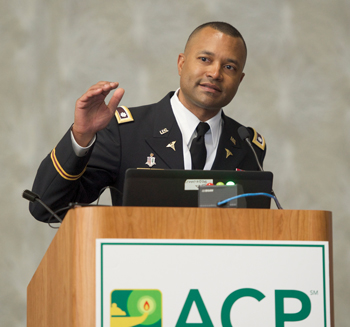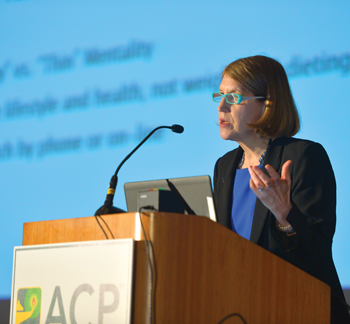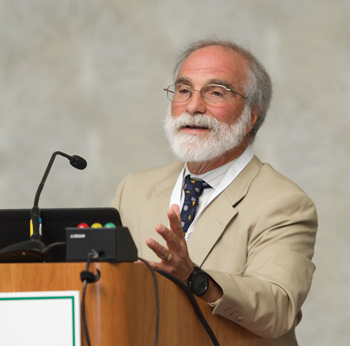High-value management of patients with GI symptoms
Gastroesophageal reflux disease, rectal bleeding, and chronic diarrhea can be controlled better by applying high-value care.
Internists who take an evidence-based approach to diagnosis and treatment can help patients break the curse of gastrointestinal symptoms without breaking the bank.
ACP Member Lt. Col. Joseph Cheatham, MD, offered several high-value recommendations for diagnosing and managing common gastrointestinal issues at his Internal Medicine Meeting 2017 session, “Gastroenterology: Cost-Conscious Care for Common Conditions.”
GERD
Gastroesophageal reflux disease (GERD) is one of the most common conditions encountered in primary care, and about 20% of the U.S. population experiences weekly symptoms such as pyrosis or regurgitation, said Dr. Cheatham, who is director of the gastroenterology fellowship program at Naval Medical Center San Diego.

“Don't underestimate patients that are coming to see you for this disease. They aren't coming just because they are having symptoms; they're having problems at work, they're having problems with sleep, disruption in their quality of life,” particularly those with nocturnal symptoms, he said.
Often, clinicians first recommend very low-cost interventions to patients, such as losing weight (GERD is strongly associated with obesity), raising the head of the bed, not consuming high-fat meals two hours before bedtime, stopping tobacco and alcohol use, and avoiding chocolate, spicy foods, and carbonated beverages, Dr. Cheatham said.
“Interestingly, only the first three interventions have any data associated with them,” he noted. However, “… if your patient tells you that reducing certain foods from their diet is helpful for them, I would support that.”
If these interventions aren't enough, there is a high level of evidence for eight weeks of daily proton-pump inhibitor (PPI) therapy, administered 30 minutes before the first meal, to relieve symptoms and reduce and heal erosive esophagitis if present, said Dr. Cheatham.
If patients partially respond to once-a-day PPI, a low-to-moderate level of evidence suggests that increasing to twice-daily dosing is likely to be beneficial, he said. If a patient does not respond to PPI therapy after four to eight weeks, a low level of evidence points to a gastroenterology referral for further workup.
What happens beyond eight weeks of therapy? “If patients develop symptoms after discontinuing their PPI, that is enough to keep them on the PPI,” Dr. Cheatham said, adding that he frequently encourages intermittent and on-demand use. Prolonged PPI use is typically indicated in patients with erosive esophagitis (because of the increased risk for developing Barrett's esophagus) and those with Barrett's esophagus (to reduce the risk of developing dysplasia), he said. “No matter what you do, long-term PPI therapy should be administered at the lowest effective dose.”
For many patients, though, an eight-week trial of the medication is enough to reduce inflammation and reduce abnormally frequent transient lower esophageal relaxations and other nonspecific esophageal motility findings that expose the esophagus to more acid, Dr. Cheatham explained. “If you reduce that inflammation, your motility comes back, and many patients don't need to be on PPIs for long periods of time after they've just had two months of therapy,” he said.
However, if they do remain asymptomatic after stopping the medication only to later redevelop symptoms, “rechallenge them with a PPI for two months and then take them off the medication again. … That's probably the most effective way to use these medications long-term” in that patient response group, said Dr. Cheatham.
Histamine H2-receptor antagonists can also improve quality of life in patients who respond to them, he said. “Just be aware of the effect of tachyphylaxis in these individuals,” said Dr. Cheatham, adding that it may be helpful to stop the medication for a few weeks to a few months before restarting. If symptom relief is achieved, these can be used as maintenance medication in patients without erosive disease, or at bedtime in addition to daytime PPI therapy in appropriate patients, he said.
Endoscopy should be reserved for patients with serious symptoms, Dr. Cheatham said. Drawing from ACP's 2012 best practice advice, he said that upper endoscopy is indicated in patients with pyrosis and the following alarm symptoms: dysphasia, bleeding, anemia, weight loss, and recurrent vomiting.
Endoscopy is also indicated in those with typical GERD symptoms that persist despite twice-daily PPI therapy and those with severe erosive esophagitis who are treated with a PPI, Dr. Cheatham said. “They should come back again to have their lower esophagus looked at to ensure that there isn't Barrett's esophagus hidden in that area of severe erosive esophagitis,” he said.
Rectal bleeding
Dr. Cheatham covered another common presentation in the clinic: painless tissue hematochezia. Of the potential sources of bleeding, hemorrhoids are the most likely culprit, he explained. “Remember that it's the internal hemorrhoids, not the external hemorrhoids, that actually bleed in your patients, so performing an anoscopy in your clinic is probably helpful to determine whether or not they actually have high-risk bleeding hemorrhoids.”
These patients typically present with bright red blood around the stool, on the tissue, or dripping in the toilet, Dr. Cheatham said. “Just because a patient says, ‘I'm sure it's not hemorrhoids because the whole toilet turns red’ is usually not a good indication that it's not hemorrhoids. You can have very high-volume bleeding from hemorrhoids, even requiring transfusions in rare cases,” he said.
The second most common etiology is probably anal fissures, Dr. Cheatham said, and “typically the hallmark is pain or spasming after the bowel movement.” Properly investigating a potential tear requires a closer look. “My fellows aren't too happy when I teach them this, but I require the patients to get up on the bed in a jackknife position—elbows on the table, knees on the table, bottom up in the air—in order for me to see around the anal wink folds to find the fissure in these patients,” he said.
Another common cause of rectal bleeding is inflammatory bowel disease (ulcerative proctitis, ulcerative colitis, or Crohn's disease). “In these patients, however, you're likely to have a lot more abdominal pain, and it's going to be probably an association with a secretory and/or an inflammatory diarrhea, so the blood is mixed with diarrhea,” said Dr. Cheatham.
Another etiology of rectal bleeding is radiation proctitis, which typically develops one to two years after radiation exposure in those treated for cervical cancer or prostate cancer, he noted. “It's made up of angiodysplasia. They're very friable, and they break with passage of stool or spontaneously on their own,” Dr. Cheatham said.
Stercoral ulcers aren't commonly talked about but should also be considered, especially by clinicians who treat elderly patients who may be in a nursing home or incapacitated, he said. “It's basically an ischemic ulcer that occurs because of stool being impacted in the rectum … and those ulcers can bleed invariably,” said Dr. Cheatham.
Finally, he said, cancer is an oft-considered etiology, and the color of blood (typically bright red, but can also be melena or maroon-colored stools) will depend on the location of the cancer. “Usually you have associated symptoms as time goes on of weight loss and perhaps even stool changes,” said Dr. Cheatham.
The role of endoscopy is clear for those with hematochezia and a strong family history of colorectal cancer or alarm symptoms (iron-deficiency anemia, hypotension, abdominal pain, stool changes, tenesmus, and weight loss), he noted, but for other patients who have painless hematochezia, age can help indicate whether flexible sigmoidoscopy or colonoscopy is appropriate.
Using data from cost-analysis studies, Dr. Cheatham explained that performing a colonoscopy is indicated and extremely cost-effective in patients older than 45 years, whether or not a bleeding source is found on digital rectal exam and anoscopy, he said.
For those younger than 35 years old, Dr. Cheatham recommended performing a digital rectal exam and anoscopy and referring them for flexible sigmoidoscopy if no source of bleeding is found. Patients “ages 35 to 45 is a little less clear,” he noted. “I think it's reasonable and cost-effective to perform a digital rectal exam with anoscopy on these individuals and refer them for either flexible sigmoidoscopy or colonoscopy if no source of bleeding is found.” Dr. Cheatham added that, for average-risk colon cancer screening with colonoscopy, the cost-effectiveness per quality life year gained at age 50 reaches parity with the use of colonoscopy in patients with tissue hematochezia at 35 years of age.
Chronic diarrhea
Chronic diarrhea is defined as two or more loose stools a day, usually for greater than four weeks at a time, and, if weighed, 200 g or more of stool passed per day, said Dr. Cheatham. It falls into three main categories—watery, fatty, and inflammatory—associated with different diseases, he said.
Although inflammatory bowel disease and irritable bowel syndrome (IBS) have overlapping symptoms, such as diarrhea and lower abdominal pain, the majority of younger adults with these symptoms have IBS, said Dr. Cheatham. He added that celiac disease is four times as prevalent in the IBS patient population as the general population, “So make sure that all of your IBS patients have at some point in their lives been evaluated for it.”
With regard to treatment of diarrhea-predominant IBS, both prescribed and over-the-counter medications are available, Dr. Cheatham said. “I think it's important to realize that you only have three FDA-approved drugs for IBS, diarrhea predominant,” he said.
Two of the drugs, rifaximin and eluxadoline, were approved in 2015, whereas alosetron has been around longer. All do a very good job of decreasing watery stool and improving IBS symptoms, as well as lessening pain and bloating, Dr. Cheatham noted. “They're all generally high-cost, although alosetron now has a generic available,” he said.
Although alosetron has been available for years, physicians don't often use it because it carries a black-box warning for the risk of ischemic colitis, Dr. Cheatham said, adding that this complication was found among patients who continued to take the medication while they were constipated. “It is a very effective drug in patients who have severe IBS and failed your other therapies, and I [encourage] you to take a look at potentially adding it to your armamentarium,” he said.
Loperamide also does a great job of reducing diarrhea. However, it doesn't do much for pain, Dr. Cheatham noted. “It is the lowest-cost option that you have, and it's very safe,” he said.
Other low-cost medication options include tricyclic antidepressants, which reduce diarrhea and lessen pain, and antispasmodics and serotonin–norepinephrine reuptake inhibitors (SSNRIs), which decrease pain but not diarrhea, Dr. Cheatham said. “It is common for loperamide to be paired with an antispasmodic or an SSNRI in order to help some patients. These are cheap but effective treatments,” he said.
Dr. Cheatham also discussed several other options for therapy. “There's actually been a very good study done on Bifidobacterium infantis, the only probiotic that I recommend to my patients,” he said. The low-cost probiotic is taken once a day and decreases diarrhea, pain, and bloating, Dr. Cheatham said. It is crucial to make sure enough bacteria are present in the product—”10 to the 10 is what I look for” in terms of colony-forming units, he noted.
Although not effective at reducing diarrhea, enteric-coated peppermint oil capsules are another low-cost option for decreasing pain and bloating, he said.
Finally, about 33% of individuals with IBS will respond to a diet low in fermentable oligo- di- and monosaccharides and polyols (FODMAPs), which has been shown to reduce diarrhea, pain, and bloating and is of low to moderate cost, Dr. Cheatham said.
However, the diet, which restricts high-FODMAP (and omnipresent) foods such as garlic and onions, is often difficult for patients to maintain completely, he noted. Dr. Cheatham said he suggests that patients refer to educational materials online to learn which foods are high and low in FODMAPs and tailor their diets accordingly.





